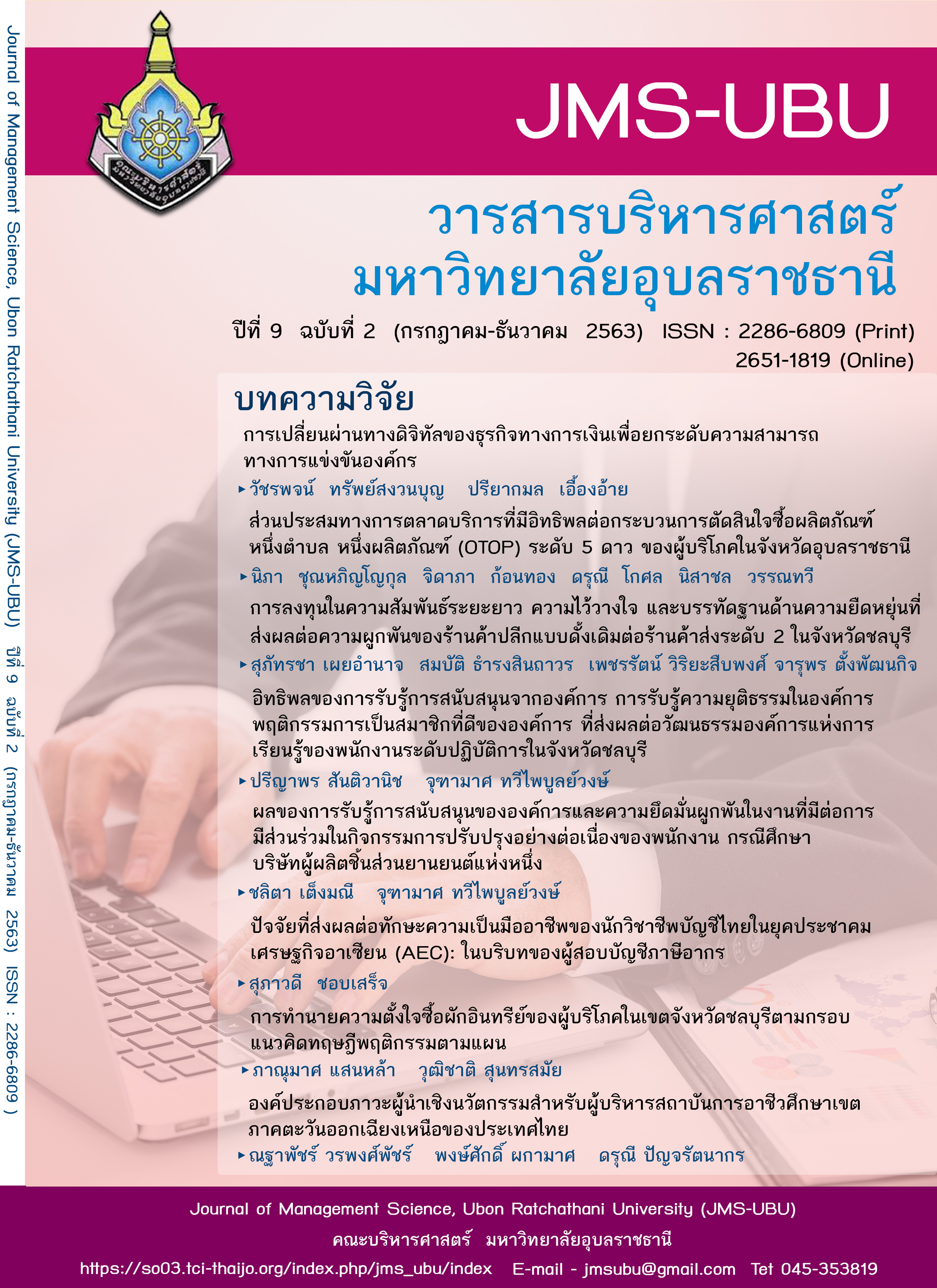การเปลี่ยนผ่านทางดิจิทัลของธุรกิจทางการเงินเพื่อยกระดับความสามารถ ทางการแข่งขันองค์กร
Main Article Content
บทคัดย่อ
งานวิจัยนี้มีวัตถุประสงค์เพื่อศึกษาแรงจูงใจในการเปลี่ยนผ่านทางดิจิทัลธุรกิจทางการเงินขององค์กร กรณีศึกษาในประเทศไทย และเพื่อวิเคราะห์ประโยชน์จากการเปลี่ยนผ่านทางดิจิทัลธุรกิจทางการเงินขององค์กร กรณีศึกษาในประเทศไทยด้วย Balanced Scorecard โดยใช้วิธีการศึกษาเชิงคุณภาพรูปแบบพหุกรณีศึกษา เก็บรวบรวมข้อมูลด้วยวิธีการสัมภาษณ์เชิงลึกจากผู้บริหารระดับสูงขององค์กรธุรกิจทางการเงิน 3 องค์กร โดยใช้การสัมภาษณ์แบบมีระบบ (Structured Interviews) ด้วยวิธีเดียวกันทั้ง 3 องค์กร เพื่อให้วิธีการเก็บรวมรวมข้อมูลถูกต้องตามความเป็นจริง ใกล้เคียงกัน ไม่เบี่ยงเบนเนื่องจากความแตกต่างในการสัมภาษณ์
ผลการศึกษา พบว่า แรงจูงใจในการเปลี่ยนผ่านทางดิจิทัลขององค์กรกรณีศึกษา คือ ปัจจัยด้านสภาวะการแข่งขันเป็นปัจจัยที่มีผลต่อการตัดสินใจเปลี่ยนผ่านทางดิจิทัลมากที่สุด ตลอดจนความต้องการในการนำเสนอสินค้าหรือบริการที่แตกต่างจากคู่แข่งและความต้องการในการอำนวยความสะดวกให้กับลูกค้า เพื่อรักษาลูกค้าเก่าและดึงดูดลูกค้าใหม่นำไปสู่การสร้างกำไรให้แก่ธุรกิจ นอกจากนี้องค์กรที่เปลี่ยนผ่านทางดิจิทัลต่างเล็งเห็นประโยชน์จากการเปลี่ยนผ่านทางดิจิทัลว่า การเปลี่ยนผ่านทางดิจิทัลส่งเสริมให้ผลการดำเนินงานมีประสิทธิภาพมากขึ้น ก่อให้เกิดการพัฒนานวัตกรรมจากการจัดการกระบวนการภายในที่มีประสิทธิภาพและการเรียนรู้เพื่อพัฒนาองค์กรให้เกิดการเติบโต ส่งผลต่อความสามารถในการจัดการด้านการเงินมีประสิทธิภาพจากการจัดการต้นทุนโดยรวมขององค์กรลดลง นำไปสู่การเพิ่มความสามารถทางการแข่งขันองค์กรได้อย่างมีประสิทธิภาพตามการวัดความสำเร็จของเชิงดุลยภาพ
Downloads
Article Details
เอกสารอ้างอิง
ชลิตพันธ์ บุญมีสุวรรณ. (2561). สังคมไร้เงินสด. วารสารธุรกิจปริทัศน์, 10(2), 235-248.
ธนาคารแห่งประเทศไทย. (2560). หลักเกณฑ์การกำกับดูแลกลุ่มธุรกิจทางการเงิน. สืบค้นจาก https://is.gd/pg1Aa0
นพพร แพทย์รัตน์. (2561). การวัดผลเชิงดุลยภาพกับการประเมินขีดความสามารถของบรรษัทภิบาลด้านเทคโนโลยีสารสนเทศ. วารสารวิจัย มสด, 14(1), 201-217.
เบญจวรรณ เบญจกรณ์ และ ภูมิพัฒณ์ มิ่งมาลัยรักษ์. (2562). การวิเคราะห์องค์ประกอบปัจจัยความสำเร็จการดำเนินงานของวิสาหกิจขนาดกลางและขนาดย่อมกลุ่มธุรกิจบริการเขตภาคเหนือตอนบน ประเทศไทยโดยใช้การวัดผลปฏิบัติงานแบบดุลยภาพ. วารสารบัณฑิตศึกษา มหาวิทยาลัยราชภัฏเชียงราย, 12(1), 13-30.
เบลล์ นาธาเนียล จิรเดชนันท์ และกฤษฎา ตันเปาว์. (2562). รูปแบบการบริหารจัดการธุรกิจประกันชีวิตที่มีประสิทธิภาพในยุคเศรษฐกิจดิจิทัลไทยแลนด์ 4.0. วารสารปัญญาภิวัฒน์, 11(1), 1-11.
มีเดียน จูมะ. (2561). ปัจจัยที่ส่งผลต่อความสามารถในการแข่งขันของผู้ประกอบการมุสลิมขนาดกลาง และขนาดย่อม ในพื้นที่สามจังหวัดชายแดนภาคใต้. วารสารวิชาการสถาบันวิทยาการจัดการแห่งแปซิฟิค, 4(1), 218-230.
ศศิประภา พันธนาเสวี. (2561). กลยุทธ์การสร้างความแตกต่างสำหรับธุรกิจบริการที่ส่งผลต่อการตัดสินใจใช้บริการร้านอาหารสไตล์เกาหลีในเขตกรุงเทพมหานคร. วารสารวิชาการบริหารธุรกิจ สมาคมสถาบันอุดมศึกษาเอกชนแห่งประเทศไทย ในพระราชูปถัมภ์ สมเด็จพระเทพรัตนราชสุดาฯ สยามบรมราชกุมารี, 7(1), 11-22.
เศรษฐพงค์ มะลิสุวรรณ และวาสนา แก้วผนึกรังษี. (2561). การเปลี่ยนผ่านทางดิจิทัลของประเทศไทยเพื่อนำไปสู่ Thailand 4.0. วารสารกสทช, 2(ธันวาคม), 24-42.
สมภาร ดอนจันดา และคณิศร ภูนิคม. (2556). ตัวชี้วัดความสำเร็จในการดำเนินธุรกิจกึ่งแสวงหากำไรโดยประยุกต์ใช้หลักการบาลานซ์สกอร์การ์ กรณีศึกษาโครงการตามพระราชดำริ. วารสารเทคโนโลยีอุตสาหกรรม มหาวิทยาลัยราชภัฏอุบลราชธานี, 3(6), 52-60.
สรร พัวจันทร์. (2562). สถาบันการเงินกับการก้าวสู่ยุคเศรษฐกิจดิจิทัล. วารสารบริหารธุรกิจและสังคมศาสตร์ มหาวิทยาลัยรามคำแหง, 2(2), 1-15.
อมรศิริ ดิสสร. (2559). ปัจจัยที่ส่งผลต่อความสำเร็จในการประยุกต์ใช้ Balanced Scorecard ของบริษัทในเขตกรุงเทพมหานคร. บัณฑิตวิทยาลัย มหาวิทยาลัยสวนดุสิต, 12(1), 59-66.
อารีย์ เชื้อเมืองพาน. (2543). วิกฤตการณ์สถาบันการเงินไทยจากอดีตถึงปัจจุบัน. วารสารเศรษฐศาสตร์มหาวิทยาลัยเชียงใหม่, 4(1), 23-35.
อุบลศิลป์ โพธิ์พรม, ประสงค์ ปราณีตพลกรัง, เปรื่อง กิจรัตน์ภร และชุณหพงศ์ ไทยอุปถัมภ์. (2553). การพัฒนาดัชนีชี้วัดความสำเร็จของการบริหารจัดการด้านเทคโนโลยีสารสนเทศและการสื่อสาร. วารสารพัฒนบริหารศาสตร์, 50(3), 149-170.
Avirutha, A. (2018). The impact of digital transformation to business performance in Thailand 4.0 era. Veridian E-Journal, Silpakorn University (Humanities, Social Sciences and arts), 11(5), 295-307.
Coraline. (2018). 4 เป้าหมายของการทำ Digital Transformation. สืบค้นจาก https://www.coraline.co.th/single-post/2018/12/03/4-goal-of-Digital-Transformation
Gomber, P., Kauffman, R. J., Parker, C., & Weber, B. W. (2018). On the fintech revolution: Interpreting the forces of innovation, disruption, and transformation in financial services. Journal of Management Information Systems, 35(1), 220-265.
Kleesoontorn, A. (2009). Teacher Encyclopedia Commemoration of His Majesty the King on the Occasion of HM the King’s 80th Birthday Anniversary. Bangkok: Office of the Welfare Promotion Commission for Teachers and Education Personnel.
Phillips, P., & Louvieris, P. (2005). Performance measurement systems in tourism, hospitality, and leisure small medium- sized enterprises: A balanced scorecard perspective. Journal of Travel Research, 44(2), 201-211.
Schwartz, E. I. (2001). Digital Darwinism: 7 Breakthrough Business Strategies for Surviving in the Cutthroat Web Economy. New York: Broadway Books.
Sebastian, I. M., Mocker, M., Ross, J. W., Moloney, K. G., Beath, C. & Fonstad, N. O., (2017). How big old companies navigate digital transformation. MIS Quarterly Executive, 16(3), 197-213.
Von Leipzig, T., Gamp, M., Manz, D., Schöttle, K., Ohlhausen, P., Oosthuizen, G., …Von Leipzig, K. (2017). Initialising customer-orientated digital transformation in enterprises. Procedia Manufacturing, 8, 517-524.
Westerman, G., Bonnet, D., & McAfee, A. (2014). The nine elements of digital transformation. MIT Sloan Management Review. Retrieved from https://sloanreview.mit.edu/article/the-nine-elements-of-digital-transformation/

